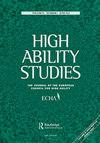The perception of creative classroom climate in elementary school students: Comparison between regular and enriched visual art classes
IF 1.8
4区 教育学
Q2 EDUCATION, SPECIAL
引用次数: 2
Abstract
ABSTRACT Creative classroom climate has an impact on the development of gifted students, but there is still not enough empirical evidence to support this hypothesis. The purpose of this study was to examine how elementary school students, aged 11 to 14 years, experience a creative environment in different educational settings. Specifically, the aim of the study was twofold: (1) to compare gifted students’ perception of creative climate in regular vs. enriched art classes, and (2) to compare the gifted students’ perception of creative climate in regular art classes with the perception of their nongifted classmates. The data were collected by using an adapted version of Péter-Szarka et al. questionnaire, which measures creative climate. The results reveal that gifted students found enriched classes more creative than regular classes. The perception of the overall creative climate in regular classes was similar in both groups of students; however, in three of the five measured dimensions of creative climate the results did point to statistical and practical significance in differences between the groups. The findings of this study offer a valuable insight into the students’ perception of a creative environment in art classes and may provide guidelines for enhancing the quality of gifted student education.小学生对创意课堂氛围的感知:普通与丰富视觉艺术课之比较
创新课堂氛围对天才学生的发展有一定影响,但目前还没有足够的实证证据支持这一假设。本研究的目的是考察11至14岁的小学生如何在不同的教育环境中体验创造性环境。具体来说,这项研究的目的有两个:(1)比较资优学生在普通艺术课和丰富艺术课上对创造力氛围的感知,以及(2)比较资优生在普通艺术班和非资优同学对创造力气氛的感知。这些数据是通过使用Péter Szarka等人的修订版问卷收集的,该问卷衡量了创造性气候。研究结果显示,资优学生发现强化班比普通班更有创造力。两组学生对普通班整体创造性氛围的看法相似;然而,在创造性气氛的五个测量维度中,有三个维度的结果确实表明了两组之间差异的统计和实际意义。这项研究的结果为学生在艺术课上对创造性环境的感知提供了宝贵的见解,并可能为提高天才学生教育质量提供指导。
本文章由计算机程序翻译,如有差异,请以英文原文为准。
求助全文
约1分钟内获得全文
求助全文
来源期刊

High Ability Studies
Multiple-
CiteScore
4.80
自引率
11.10%
发文量
7
期刊介绍:
High Ability Studies provides a forum for scholars in a variety of disciplines associated with the development of human abilities to their highest level. It is a medium for the promotion of high ability, whether through the communication of scientific research, theory, or the exchange of practical experience and ideas. The contents of this journal are unique in reflecting concerns and recent developments in this area from childhood and across the whole life span in a variety of contexts. Far from being restricted to the traditional focus on high-level cognitive development, it also presents investigations into all other areas of human endeavour, including sport, technology, the arts, business, management and social relations.
 求助内容:
求助内容: 应助结果提醒方式:
应助结果提醒方式:


